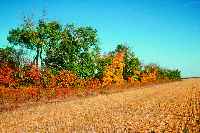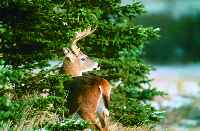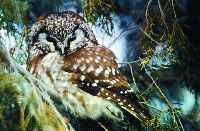| |
Beneficial Management Practices: Environmental Manual for Crop Producers in Alberta - Non-cropped Land | |
| |
|
|
| |
|
|
| | Non-cropped land includes land used for native hay, pasture, shelterbelts, woodlots, bush, abandoned farmsteads and field borders. This land often has patches of native plants needed for wildlife habitat.
BMPs to improve habitat on non-cropped land include:
- Retain existing natural areas to provide habitat for birds, small mammals, and insects.
- Enhance the habitat value of treed areas, including shelterbelts, by such practices as adding fruit- and nut-producing trees and shrubs and leaving dead trees, to provide habitat for birds, small mammals, insects and fungi.
- Provide or retain corridors between key habitat areas to provide shelter for wildlife moving between these areas. Fencelines and shelterbelts can be used as corridors.
- For hay land, use a flushing bar during haying. Delay haying near wet areas to minimize nesting losses for ground-nesting birds; wait until at least July 1, and, whenever possible, delay until about mid-July, when nesting is usually near completion.
- For pasture land, avoid overgrazing, and delay spring grazing near wet areas to minimize damage to nests.
- Enhance the habitat value of idle areas like field borders and abandoned farmyards by such practices as planting a variety of grasses, legumes or shrubs, and adding nesting boxes.
- Maintain the edges between habitat types because these areas usually have more diverse food and cover.

Fencelines can be used as travel corridors.
Courtesy of Agriculture and Agri-Food Canada - PFRA

Spruce trees provide high quality winter cover.
Courtesy of Agriculture and Agri-Food Canada - PFRA

Northern saw-whet owls often nest in standing dead trees with old woodpecker cavities.
Courtesy of Agriculture and Agri-Food Canada - PFRA
Back to Chapter 7 - Wildlife Habitat |
|
| |
|
|
| |
For more information about the content of this document, contact Roger Bryan.
This document is maintained by Jennifer Rutter.
This information published to the web on November 1, 2004.
Last Reviewed/Revised on October 30, 2017.
|
|